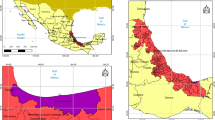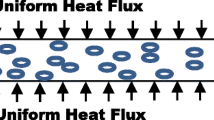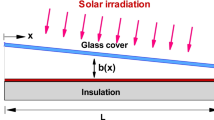Abstract
A mathematical model was developed to be used for numerical analysis of heat and mass transfer processes in the experimental section of the air condenser (ESAC) created in the Scientific Production Company (SPC) “Turbocon” and mounted on the territory of the All-Russia Thermal Engineering Institute. The simulations were performed using the author’s CFD code ANES. The verification of the models was carried out involving the experimental data obtained in the tests of ESAC. The operational capability of the proposed models to calculate the processes in steam–air mixture and cooling air and algorithms to take into account the maldistribution in the various rows of tube bundle was shown. Data on the influence of temperature and flow rate of the cooling air on the pressure in the upper header of ESAC, effective heat transfer coefficient, steam flow distribution by tube rows, and the dimensions of the ineffectively operating zones of tube bundle for two schemes of steam–air mixture flow (one-pass and two-pass ones) were presented. It was shown that the pressure behind the turbine (in the upper header) increases significantly at increase of the steam flow rate and reduction of the flow rate of cooling air and its temperature rise, and the maximum value of heat transfer coefficient is fully determined by the flow rate of cooling air. Furthermore, the steam flow rate corresponding to the maximum value of heat transfer coefficient substantially depends on the ambient temperature. The analysis of the effectiveness of the considered schemes of internal coolant flow was carried out, which showed that the two-pass scheme is more effective because it provides lower pressure in the upper header, despite the fact that its hydraulic resistance at fixed flow rate of steam–air mixture is considerably higher than at using the one-pass schema. This result is a consequence of the fact that, in the two-pass scheme, the condensation process involves the larger internal surface of tubes, results in lower values of Δt (the temperature difference between internal and external coolant) for a given heat load.
Similar content being viewed by others
References
J. F. Kenny, N. L. Barber, S. S. Hutson, K. S. Linsey, J. K. Lovelace, and M. A. Maupin, Estimated use of water in the United States in 2005, US Geological Survey Circular 1344, (2009).
O. O. Mil’man and P. A. Anan’ev, “Dry cooling towers and air-condensation plants (review),” Therm. Eng. 63 (2016), (in press).
O. N. Favorskii, A. I. Leont’ev, V. A. Fedorov, and O. O. Mil’man, “Air condensers—foundations of heat removing system from steam—turbine plants in XXI century,” Energetik, No. 6, 54–55 (2013).
H. Zhai and E. S. Rubin, “Performance and cost of wet and dry cooling systems for pulverized coal power plants with and without carbon capture and storage,” Energ. Policy 38, 5653–5660 (2010). doi 10.1016/j.enpol.2010.05.013
J. G. Bustamante, A. S. Rattner, and S. Garimella, “Reducing the performance penalty of air-cooled condensers in power plants,” Appl. Thermal Eng. (in press), (2015). doi 10.1016/j.applthermaleng.2015.05.065
J. R. Bredell, D. G. Kröger, and G. D. Thiart, “Numerical investigation of fan performance in a forced draft air-cooled steam condenser,” Appl. Thermal Eng. 26, 846–852 (2006). doi 10.1016/j.applthermaleng. 2005.09.020
J. A. van Rooyen and D. G. Kröger, “Performance trends of an air-cooled steam condenser under windy conditions,” J. Eng. for Gas Turbines and Power 130, 023006 (2008). 1 doi 10.1115/1.2771567
M. T. F. Owen, Air-Cooled Condenser Steam Flow Distribution and Related Dephlegmator Design Considerations (Stellenbosch Univ., Stellenbosch, 2013). http://scholar.sun.ac.za/handle/10019.1/85731
M. T. F. Owen and D. G. Kröger, “The effect of screens on air-cooled steam condenser performance under windy conditions,” Appl. Thermal Eng. 30, 2610–2615 (2010). doi 10.1016/j.applthermaleng.2010.07.017
P. Liu, H. Duan, and W. Zhao, “Numerical investigation of hot air recirculation of air-cooled condensers at a large power plant,” Appl. Thermal Eng. 29, 1927–1934 (2009). doi 10.1016/j.applthermaleng.2008.09.011
X. Zhang and H. Chen, “Effects of windbreak mesh on thermo-flow characteristics of air-cooled steam condenser under windy conditions,” Appl. Thermal Eng. 85, 21–32 (2015). doi 10.1016/j.applthermaleng.2015.04.004
V. I. Artemov, K. B. Minko, and G. G. Yan’kov, Modeling steam condensation from steam–air mixture in the inclined tubes of an air–cooled condenser, Therm. Eng. 61, 30–40 (2014). doi 10.1134/S0040363614010019
V. A. Fedorov, O. O. Mil’man, P. A. Anan’ev, S. N. Dunaev, N. V. Kolesnikov, and B. A. Shifrin, “Thermal–hydraulic processes in air condensers of the steam–gas installations,” Vestn. Mos. Energ. Inst., No. 2, 5–12 (2012).
V. A. Fedorov, O. O. Mil’man, N. V. Kolesnikov, P. A. Anan’ev, S. N. Dunaev, A. M. Mikhal’kov, A. V.Mosin, and A. V. Kondrat’ev, “Results from experimental investigations of the performance of air condensers for steam turbine units,” Therm. Eng. 60, 111–117 (2013). doi 10.1134/S0040363613020021
V. I. Artemov, K. B. Minko, and G. G. Yankov, “Numerical simulation of heat and mass transfer processes in air–cooled condenser,” Proc. 15th Int. Heat Transfer Conf. (IHTC-15), Kyoto, Japan, 2014. doi 10.1615/IHTC15.cds.00953610.1615/IHTC15.cds.009536
V. I. Artemov, V. M. Zorin, A. S. Shamarokov, and G. G. Yan’kov, “Simulation of processes in the air heat transferr of the system for emergency cooling of a BN-800 reactor installation,” Therm. Eng. 51, 202–210 (2004).
A. A. Zhukauskas, Collective Transfer in Heat Transferrs (Nauka, Moscow, 1982) [in Russian].
G. F. Hewitt, Heat Transferr Design Handbook (Begell House, 2002).
A. Zapke and D. G. Kröger, “Counter current gas–liquid flow in inclined and vertical ducts-I: Flow patterns, pressure drop characteristics and flooding,” Int. J. Multiphase Flow 26, 1439–1455 (2000). doi 10.1016/S0301-9322(99)00097-X
O. O. Mil’man, A. V. Kondrat’ev, A. V. Ptakhin, S. N. Dunaev, and A. V. Kiryukhin, “The varying duties of air–condensation unit work,” Therm. Eng. 63, 2016 (in press).
Author information
Authors and Affiliations
Corresponding author
Additional information
Original Russian Text © V.I. Artemov, K.B. Minko, G.G. Yan’kov, A.V. Kiryukhin, 2016, published in Teploenergetika.
Rights and permissions
About this article
Cite this article
Artemov, V.I., Minko, K.B., Yan’kov, G.G. et al. Simulation of heat and mass transfer processes in the experimental section of the air-condensing unit of Scientific Production Company “Turbocon”. Therm. Eng. 63, 319–328 (2016). https://doi.org/10.1134/S0040601516050013
Published:
Issue Date:
DOI: https://doi.org/10.1134/S0040601516050013




